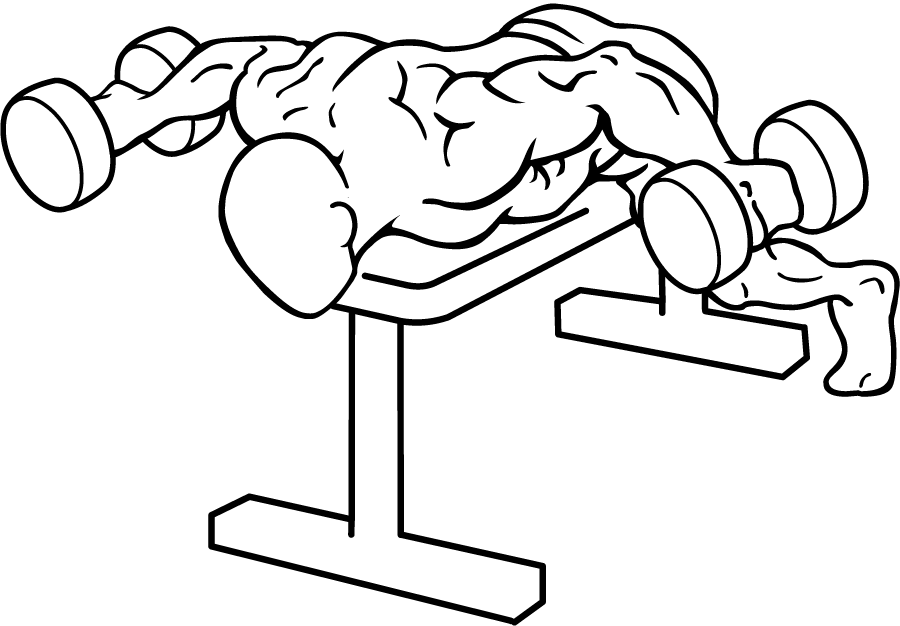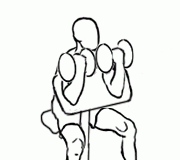Last Updated on September 27, 2014
The lying rear lateral raise is a powerful exercise that targets the posterior (rear) deltoids, helping to improve shoulder strength, stability, and overall definition. Unlike other shoulder exercises, this movement minimizes momentum and isolates the rear delts, making it one of the best exercises for balanced shoulder development. Whether you’re new to shoulder training or looking to refine your routine, this guide will walk you through the essentials of the lying rear lateral raise, its benefits, tips for proper form, variations to try, and how to integrate it effectively into your workout routine.
Why the Lying Rear Lateral Raise is Essential for Shoulder Development
- Targets the Often-Underdeveloped Rear Deltoids
Many shoulder exercises emphasize the front and middle deltoids, leaving the rear deltoids underdeveloped. Strengthening the rear delts helps create a balanced, sculpted look and ensures even shoulder strength. - Improves Shoulder Stability
Strong rear delts play a vital role in stabilizing the shoulder joint. This stability is crucial for preventing injuries during compound movements like bench presses, overhead presses, and rows. - Enhances Posture
Regularly working the rear delts can improve posture, especially for those with rounded shoulders. Strong rear delts pull the shoulder blades back, which helps counteract forward-leaning posture. - Boosts Upper Body Strength and Aesthetics
A well-rounded shoulder enhances the appearance of the upper body. Defined rear delts add depth and contribute to a strong, balanced physique, essential for athletes and fitness enthusiasts alike. - Reduces Shoulder Pain
By strengthening the muscles that support the shoulder joint, the lying rear lateral raise can help reduce common shoulder discomfort often caused by muscle imbalances and poor posture.
How to Perform the Lying Rear Lateral Raise: Step-by-Step Guide
Follow these steps to perform the lying rear lateral raise with proper form to maximize effectiveness and prevent injury:
1. Set Up the Bench and Dumbbells
Place two dumbbells at the head of a raised bench. Choose a bench high enough so that your arms can move freely beneath it without hitting the floor.
2. Position Yourself on the Bench
Lie facedown on the bench with your chest and stomach resting on the surface. Position your toes on the floor for stability, ensuring your body is secure and comfortable.
3. Grasp the Dumbbells
Reach forward and grasp the dumbbells with your palms facing inward. Start with a manageable weight to ensure proper form, as this exercise emphasizes control and isolation.
4. Position Your Arms
With a slight 30-degree bend in your elbows, let your arms hang down from the bench. This is your starting position.
5. Lift the Dumbbells to Shoulder Height
Exhale as you lift the dumbbells outward in a wide arc until your arms reach shoulder height. Keep a slight bend in your elbows and avoid flaring them out too much. Focus on using the rear delts to lift rather than swinging the weights.
6. Hold for a Brief Squeeze
Once at the top, pause briefly to maximize the contraction in your rear delts.
7. Lower the Dumbbells Slowly
Inhale as you slowly lower the dumbbells back to the starting position, keeping the movement controlled. This eccentric phase is crucial for maintaining tension on the rear delts.
8. Repeat for Desired Repetitions
Complete your chosen number of reps before resting. Aim for 3–4 sets to get the most out of this exercise.
Tips for Effective Lying Rear Lateral Raises
- Keep Movements Controlled
Control is essential for this exercise. Avoid swinging the weights up, as this reduces tension on the rear delts and increases the risk of shoulder strain. - Engage Your Core
Even though you’re lying down, engage your core to provide extra stability. A stable core ensures that the focus remains on the shoulders without any unnecessary movement. - Use an Appropriate Weight
Start with lighter weights to master the movement. Because this exercise isolates a small muscle group, going too heavy can compromise form and reduce effectiveness. - Focus on the Mind-Muscle Connection
Concentrate on contracting your rear delts throughout each rep. Visualizing the rear delts working can improve engagement and overall results. - Don’t Lift Too High
Lifting beyond shoulder height places unnecessary strain on the shoulder joint. Keep the dumbbells level with your shoulders for optimal muscle engagement and joint safety.
Common Mistakes to Avoid
- Using Excessive Weight
Lifting too heavy can lead to poor form and involve muscles other than the rear delts. Start with a manageable weight that allows you to complete each rep with control. - Swinging the Dumbbells
Using momentum reduces the effectiveness of the exercise. Focus on controlled, steady movements to ensure maximum rear delt activation. - Flaring the Elbows
Keep a slight bend in your elbows and avoid flaring them out too wide, as this can put strain on the shoulder joint and compromise rear delt isolation. - Not Engaging the Core
Allowing your torso to shift can lead to instability, reducing focus on the rear delts. Keep your core tight and your body stable on the bench. - Neglecting the Lowering Phase
Quickly lowering the dumbbells wastes the eccentric (lowering) portion of the movement. Take your time to lower the weights in a controlled manner, maintaining tension on the rear delts.
Variations of the Lying Rear Lateral Raise
To add variety and challenge to your rear delt training, consider these effective variations:
- Incline Bench Rear Lateral Raise
Use an incline bench set at about 30–45 degrees. This slight incline offers a different angle and reduces shoulder strain, making it ideal for those with shoulder sensitivities. - Cable Rear Lateral Raise
Set up a low pulley cable attachment and perform the movement while lying or standing. The cable provides constant tension, increasing engagement and control. - Seated Bent-Over Rear Lateral Raise
Sit on the edge of a bench, lean forward, and perform the rear lateral raise. This seated version reduces core involvement, allowing you to focus on shoulder isolation. - Two-Arm Rear Lateral Raise
Instead of using one arm, perform the movement with both arms simultaneously. This version increases stability demands and adds a symmetrical aspect to your shoulder workout. - Slow Tempo Rear Lateral Raise
Slow down each phase of the lift, especially the lowering portion, to increase time under tension. This variation challenges the rear delts and improves muscle control.
Incorporating the Lying Rear Lateral Raise into Your Workout
Here are some ways to incorporate the lying rear lateral raise into your shoulder or upper body routine for maximum benefit:
- Strength Training
For strength, perform 3–4 sets of 6–8 reps with a moderate weight. This rep range allows you to lift heavier while maintaining form, enhancing shoulder strength. - Hypertrophy (Muscle Growth)
For muscle growth, aim for 3–4 sets of 8–12 reps with a lighter weight. This range helps create muscle tension and is ideal for building well-defined rear delts. - Endurance and Tone
For endurance and toning, perform 2–3 sets of 15–20 reps with a lighter weight. High reps increase muscular endurance and improve definition without bulk. - Use as a Finisher
Include the lying rear lateral raise as a finisher at the end of your shoulder workout to fully exhaust the rear delts. Perform 2–3 sets of 12–15 reps to enhance muscle definition. - Pair with Compound Shoulder Exercises
Combine this exercise with compound movements like shoulder presses or upright rows for a comprehensive shoulder routine that works all three heads of the deltoids.
Safety Tips for Performing the Lying Rear Lateral Raise
- Start with Light Weights
This exercise emphasizes control and isolation, so start with lighter weights. Gradually increase the weight as your form improves to prevent shoulder strain. - Focus on Elbow Position
Keep a slight bend in your elbows to reduce joint strain. Avoid locking out or hyperextending the elbows to maintain tension on the rear delts. - Engage Your Core
Keep your core tight to prevent torso movement, which helps isolate the shoulders and minimizes strain on other areas. - Avoid Lifting Too High
Lifting above shoulder height can lead to joint strain. Aim to lift until your upper arms are parallel to the floor for optimal muscle activation and safety. - Progress Gradually
Gradually increase the weight and reps over time. Building shoulder strength and stability requires patience and control, so avoid rushing progress.
Frequently Asked Questions
Q1: Is the lying rear lateral raise suitable for beginners?
A: Yes, it’s a beginner-friendly exercise that can help develop shoulder strength and stability. Beginners should start with lighter weights to master the form.
Q2: How often should I perform the lying rear lateral raise?
A: Include this exercise in your shoulder routine once or twice a week, with at least 48 hours between sessions for muscle recovery.
Q3: Should I perform this exercise with cables?
A: Yes, using a cable machine is an excellent option for the rear lateral raise, as it provides continuous tension throughout the movement, which can enhance muscle activation. Cables also offer a smoother range of motion, which some people find more comfortable than free weights.
Q4: Can I replace other rear delt exercises with the lying rear lateral raise?
A: While the lying rear lateral raise is fantastic for isolating the rear delts, it’s best to use it in conjunction with other rear delt exercises, such as face pulls or bent-over lateral raises. This ensures you’re hitting the rear delts from multiple angles for balanced shoulder development.
Q5: Is it normal to feel shoulder fatigue during this exercise?
A: Yes, since this exercise isolates the rear delts, you should feel fatigue in that area by the end of your set. However, if you experience sharp pain or discomfort, it may be a sign of incorrect form or excessive weight. Always prioritize proper technique over heavy lifting.
Advanced Tips for Maximizing Results from the Lying Rear Lateral Raise
- Slow Down the Eccentric Phase
Emphasize a slow descent as you lower the dumbbells back to the starting position. Taking 3–4 seconds during the eccentric phase keeps tension on the rear delts, promoting muscle growth and improving control. - Add Isometric Holds at the Top
Hold the dumbbells at shoulder height for 1–2 seconds at the top of each rep. This brief isometric hold intensifies the contraction in the rear delts, maximizing engagement and leading to better strength gains. - Incorporate Drop Sets
For an intense finisher, try drop sets by completing a set to failure, reducing the weight, and performing additional reps until failure again. Drop sets exhaust the rear delts, encouraging muscle hypertrophy through maximum fatigue. - Experiment with Different Rep Ranges
Mix up your rep ranges to prevent plateaus and stimulate new growth. Alternate between low reps with heavier weights and high reps with lighter weights in different sessions to continually challenge the rear delts. - Enhance the Mind-Muscle Connection
Concentrate on your rear delts working during each lift. Visualizing the muscle contraction can improve the mind-muscle connection, leading to more effective workouts and better muscle activation over time.
Wrapping Up: Strengthen and Sculpt Your Rear Delts with the Lying Rear Lateral Raise
The lying rear lateral raise is a valuable addition to any shoulder workout, providing a focused, effective way to build the rear deltoids. By isolating the often-neglected rear delts, this exercise helps create balanced shoulder strength, stability, and improved posture.
Whether you’re aiming for enhanced upper body aesthetics, functional strength, or injury prevention, this exercise supports a well-rounded shoulder development program. Start with lighter weights, prioritize controlled movements, and incorporate advanced techniques as you progress for the best results. With consistency and dedication, the lying rear lateral raise can help you build strong, sculpted shoulders that not only look impressive but also support overall upper body strength and resilience.
Add the lying rear lateral raise into your routine to see noticeable improvements in your shoulder strength, definition, and posture. With the right approach, this exercise will contribute significantly to your fitness goals and bring balance to your upper body training.








